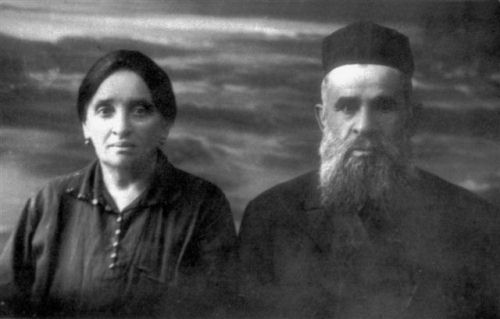
|
|
|
|
Micha Baron: I didn't leave before saying goodbye to Chaya-Sarah, sister of my grandmother Sheine-Chana
|
|
| Mirka Baron at Hachshara “As a memento to my parents and family from your daughter Miryam. Kibbutz Hasneh in Alite [Alitus], 17.4.1934” |
On Sunday afternoon I left Lithuania.
At the train station in Kovno, I was introduced to my “wife”. Her father lived in South Africa and sent her “funts” (pounds). She offered me some candy.
In Berlin, the promised guide did not arrive, and I “guided” us through the city. Hitler was already in power and SS troops were seen in the streets. From Berlin via Austria, we went to Trieste. In Trieste, we stayed in a house belonging to the Sochnut (Jewish Agency). We walked in the port vicinity, went to the market where we saw fruit; grapes and oranges, and suddenly it started raining, and we returned wet. In the afternoon, we reached the port and boarded the ship “Pilsana”, a luxurious Italian ship.
The trip took five days. The first class had a swimming pool, and the other classes had chalutzim (pioneers). We were dancing and singing. The mood was high. We wandered around the ship. The food was good. We were four friends. We knew no Italian, but managed with our hands, and with a few lirettas, got to eat in first class where the food was superb.
On September 3, 1934, we reached Haifa port.
The Sochnut people and members of kibbutz Ein Hamifratz welcomed us. The kibbutz was then situated on the sands of Qiryat Motzkin. I remember we reached it directly from the port and did not go via Beit Ha'Olim (the Absorption Center). On the next day, Friday, I visited a Dusiater, Avraham Slep, and I remember the address Rehov Dalet #9, Qiryat Chaim until now.
A month later, I moved to kibbutz Gan Shmuel, to a complementary group.
I was there for a year. We were not well received. The “veterans” were older. They were about forty people. We, the younger people, were expected to add another eighty. Many discussions were held on this topic. They had houses. Among the veterans were families; they ate meat daily; they already had a tractor; they received the first combine (for farming), the first machbesh (roller). We looked upon them as a bourgeois kibbutz, not according to our education. We were well absorbed at work, but socially we did not connect. We, the eighteen year olds, did not have a say. We wanted to start a new kibbutz.
|
JewishGen, Inc. makes no representations regarding the accuracy of
the translation. The reader may wish to refer to the original material
for verification.
JewishGen is not responsible for inaccuracies or omissions in the original work and cannot rewrite or edit the text to correct inaccuracies and/or omissions.
Our mission is to produce a translation of the original work and we cannot verify the accuracy of statements or alter facts cited.
 Dusetos, Lithuania
Dusetos, Lithuania
 Yizkor Book Project
Yizkor Book Project
 JewishGen Home Page
JewishGen Home Page
Copyright © 1999-2026 by JewishGen, Inc.
Updated 26 Oct 2008 by LA